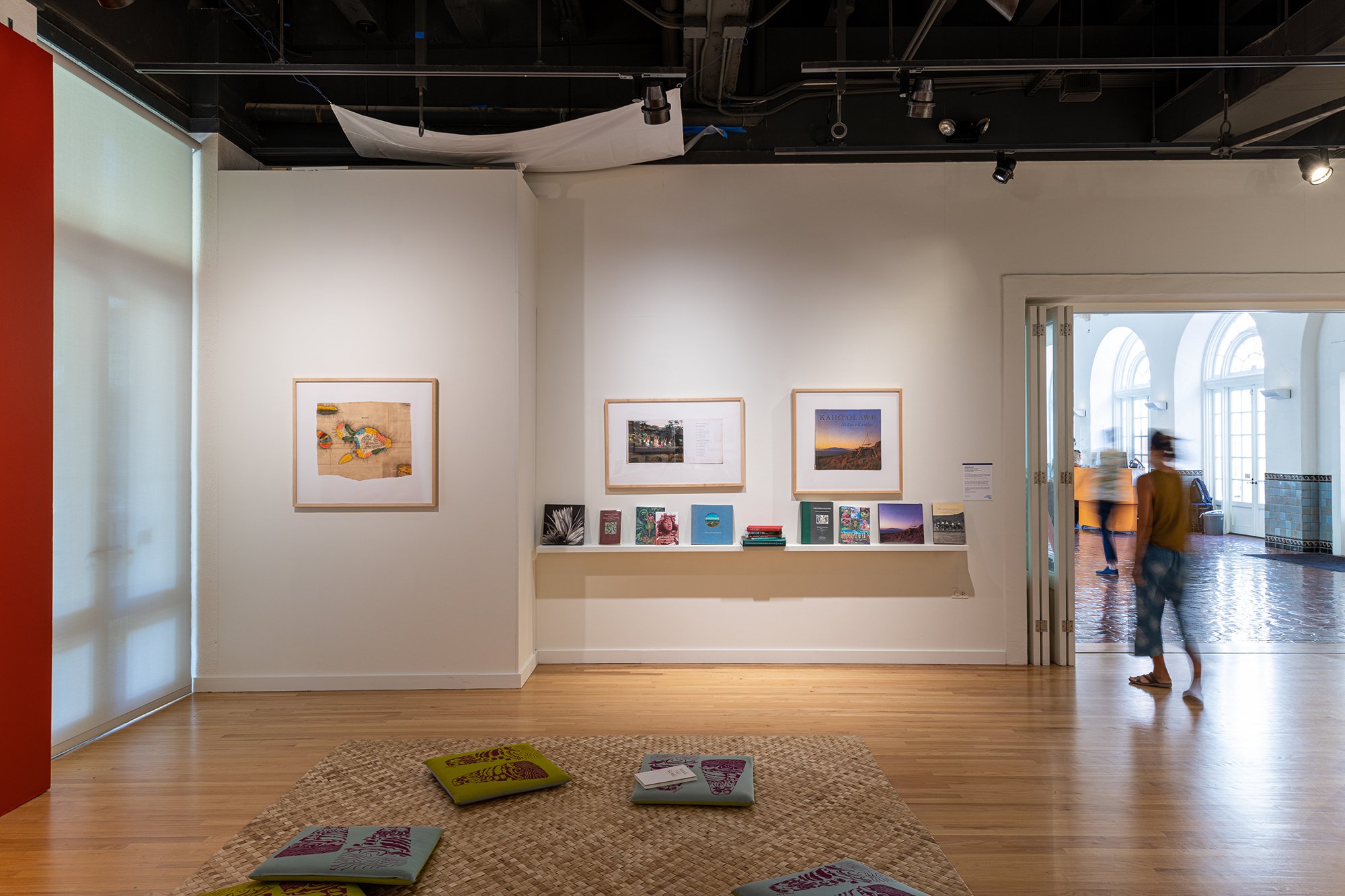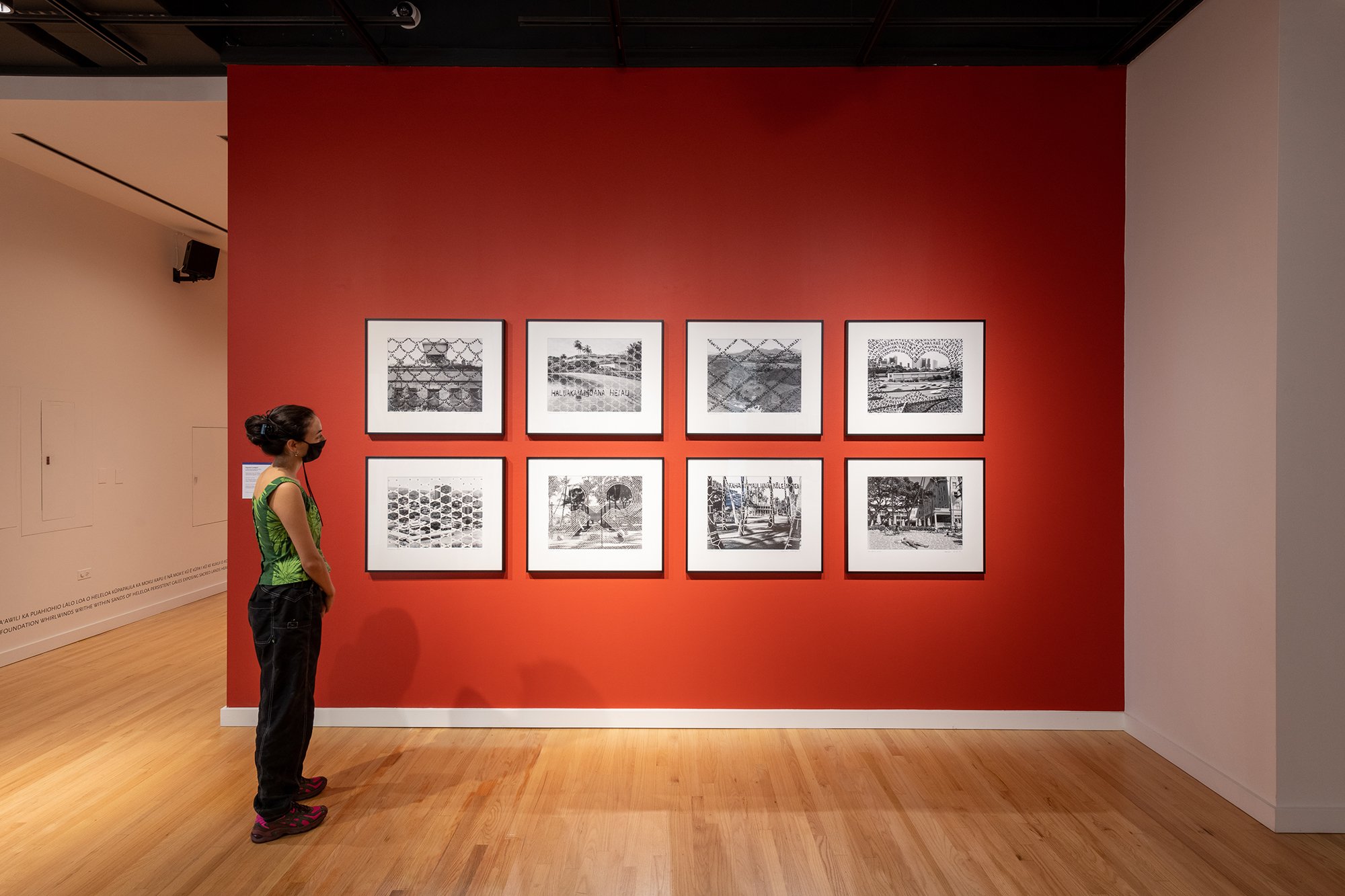hawai‘i triennial 2022
@ HAWAI‘I STATE ART MUSEUM
ʻAi Pōhaku Press
Maile Meyer
b. 1957, Kailua, Koʻolaupoko, Oʻahu; lives and works in Honolulu, Kona, Oʻahu
Barbara Pope
b. 1951, Maunawili, Koʻolaupoko, Oʻahu; lives and works in Maunawili
Installation views: ʻAi Pōhaku Press, Reading Room (top left and above) with moena alolua by Keanahala and seat cushions by TUTUVI; Kapulani Landgraf, Selections from ʻAi Pōhaku (top middle), 1993; Hawai‘i State Art Museum, HT22, Honolulu. Courtesy of the artist and Hawai‘i Contemporary. Photos: Christopher Rohrer.
ʻAi Pōhaku Press was established by community organizer Maile Meyer and book designer Barbara Pope in 1993, as an act of healing to mark the 100th anniversary of the illegal overthrow of the Kingdom of Hawaiʻi. At its foundations, the press is an expression of the pilina that Meyer and Pope have with words, images, books, communities, one another, and Hawaiʻi.
Ua ola makou i ka pohaku
I ka ai kamahao o ka Aina
For nearly three decades, Meyer, Pope, and their many collaborators from a wide range of disciplines have been more than satisfied with stones—astonishing spirit food of the land. As its name suggests, ‘Ai Pōhaku Press believes in perpetuating enduring Hawaiian worldviews and resisting the exhausted structures and systems of settler colonialism.
Although Pope and Meyer are both from families known for strong, opinionated, and eccentric women, born and raised on the windward side of Oʻahu—one up mauka and the other makai—and attended the same school, ‘over the Pali’, they did not meet until their paths crossed at Bernice Pauahi Bishop Museum in the 1980s. Meyer had been hired to oversee press, marketing, and distribution, and Pope was working on ‘Ōlelo No‘eau: Hawaiian Proverbs and Poetical Sayings (1983), a life-changing publication by Mary Kawena Pukui (1895–1986), a revered scholar, composer, kumu hula, and vital researcher at the museum.
At the time, Bishop Museum Press was at the height of its productivity with a worldwide reputation in scholarly publications, academic journals, and a growing trade list focused on Hawaiʻi and the Pacific. Pope and Meyer were part of an effort to increase access to written and visual knowledge from the museum’s vast and mostly private holdings. Ultimately, the two left the museum and shared an office on Aupuni Street in Kalihi, Oʻahu, where Meyer developed a Native bookstore and Pope a book design company, both dedicated to publications of Hawaiʻi. ʻAi Pōhaku emerged from the work they instinctively did together during the late 1980s and early 1990s. The press combined their interests, abilities, and long friendship founded on their shared commitment to publishing books connected to ʻāina through storied-telling and imagery imbued with kaona and the value systems of Ka Paeʻāina o Hawaiʻi.
In support of the transformative potential of researching, writing, publishing, and reading, ‘Ai Pōhaku has contributed a study room to HT22. Within its permeable walls are an extensive selection of titles, some released by the press and others relevant to its ethos. The installation also features portraits of cherished elders and community leaders Iolani Luahine, Mary Kawena Pukui, Gabby Pahinui, Ruth Makaila Kaholoaa, Myrna and Eddie Kamae, Sam Liʻa Kalainaina, Reverend Roy Toko, Eddie Thomas, the Sons of Hawaiʻi, Papa Auwae, Denis Kanaʻe Keawe, Mahealani Kamauu, and Craig Neff; reproductions of book covers including Kaho‘olawe: Nā Leo O Kanaloa, Nā Wahi Kapu O Maui, Ē Luku Wale Ē; photographs of place; historical maps; a lauhala moena by Keanahala, a community weaving program; and the poem ‘Hawaiʻi ’88’ by poet and activist Dana Naone Hall, part of which is reproduced below:
It’s true that the man
who swam with sharks
and kept them away
from the nets full of fish
by feeding them limu kala
is gone,
but we’re still here
like the fragrant white kokiʻo
blooming on the long branch
like the hairy-leafed nehe
clinging to the dry puʻu
like the moon high over Haʻikū
lighting the way home.
Eō. Inspired by the ongoing energies of many and by their participation in HT22, Pope and Meyer have recommitted themselves to publishing again under the ʻAi Pōhaku Press imprint.





